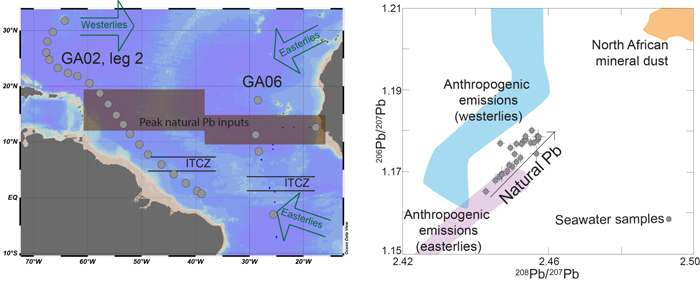Testament of the efficiency of environmental policies
Human activities, such as the combustion of leaded petrol, emissions from non-ferrous metal smelting, coal combustion and waste incineration constitute major environmental lead (Pb) sources during the past century. This resulted in a considerable increase of anthropogenic Pb in the surface and deep waters of the North Atlantic, large enough to mask the natural lead signal.
Increased usage and then phasing-out of leaded-petrol since the mid-70’s yielded a decrease of this contamination. By measuring lead concentrations and isotopes (excellent tracers of the different sources of lead) along the GEOTRACES sections GA02 and GA06, Bridgestock and his co-workers (2016, see reference below) reveal for the first time that natural lead can be detected again in the surface water of the North Atlantic. Indeed, significant proportions of up to 30–50% of natural Pb, derived from mineral dust, are observed in Atlantic surface waters off the Sahara. This clearly reflects the success of the global effort to reduce anthropogenic Pb emissions.

Figure: Locations of the surface seawater samples analyzed in this study (left). The brown shaded box shows the area found to contain the highest amounts of naturally sourced lead (Pb) resulting from the deposition of North African mineral dust. Significant inputs of natural Pb can be identified by higher Pb isotope ratio values (206Pb/207Pb and 208Pb/207Pb; right).
Reference:
Bridgestock, L., van de Flierdt, T., Rehkämper, M., Paul, M., Middag, R., Milne, A., Lohan, M.C., Baker, A.R., Chance, R.,, Khondoker, R., Strekopytov, S., Humphreys-Williams, E., Achterberg, E.P., Rijkenberg, M.J.A., Gerringa, L. J.A., de Baar, H. J. W. (2016). Return of naturally sourced Pb to Atlantic surface waters. Nature Communications, 7, 12921. doi:10.1038/ncomms12921
